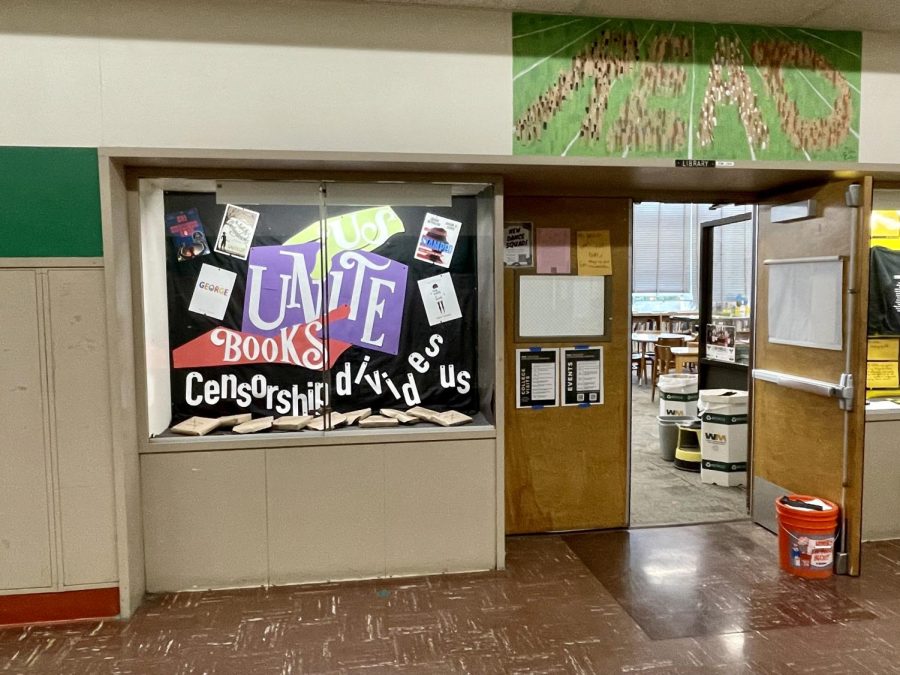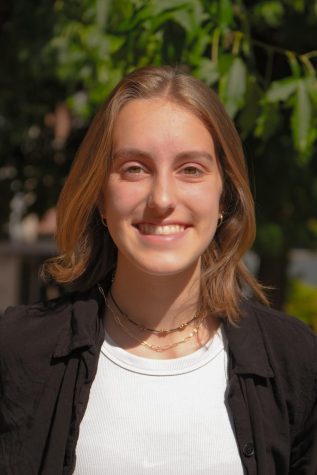Banned Books? Banned Perspectives.
October 25, 2021
Resting in a case outside of the Ida B. Wells-Barnett library is a display passed by students every day, reading “Books Unite Us, Censorship Divides Us.” At the bottom of the case, books lay eerily covered in beige paper and images of popular books such as “The Hate U Give” and “To Kill a Mockingbird.” line the walls. However, few students understand the display and the implications of the message it sends.
“Books Unite Us, Censorship Divides Us,” is the theme from this year’s Banned Books Week, a week-long event at the end of September, created by the American Library Association, celebrating the ability and freedom of access to literature.
Banned Books Week is also a time to analyze the previous year’s top 10 challenged books list, or books that are often on the pathway to becoming banned. 2020’s list is much like past years’, including many books with LGBTQ+ characters, but this year’s list has one critical difference—the drastic uptick in race or racial-justice related books.
Susan Stone, the district Teacher-Librarian for Portland Public Schools, explained the process of “challenging” a book, and said that, “When a community member has a concern over a library material or textbook, they are welcome to first connect with the teacher-librarian in the building to discuss the concern.” This is called a “challenge” because it is not immediately banned simply due to concern. Further discussion with administration and the completion of a Request for Reconsideration of Materials form can follow.
Although books are certainly challenged throughout Portland Public Schools, few have been fully banned, and others are even used in school curricula.
A book central to the ninth-grade curriculum at Ida B. Wells, “All American Boys” by Jason Reynolds and Brandon Kiely, sits at number three on 2020’s most challenged books list.
The book was challenged frequently this past year because it was “thought to promote anti-police views, contain divisive topics, and be ‘too much of a sensitive matter right now’,” according to the American Library Association.
“What we’ve seen over the years is the shift from banning sex, drugs, and rock and roll, to banning various people’s perspectives, especially perspectives written by people of color and LGBTQ folks,” said Ida B. Wells Librarian, Cassie Lanzas. This is especially harmful for children in school whose thoughts and opinions towards others are being formed for the first time. With such a lack of exposure to different people, ideas, or opinions, serious problems can arise. “When you start banning perspectives, then you’re limiting the points of view that kids have access to and you’re creating an artificially narrow world for them to live in,” she said.
In a predominantly white, liberal city, Portland Public Schools students can also be stuck in their own bubble, but many believe that valuable precautions are being made to prevent the lack of exposure to other ideas or opinions.“I do think that our school is making a real effort to have diverse voices in the classroom, and they are voices that are being banned in other places in the United States,” Lanzas said.
While Ida B. Wells High School has been relatively willing to incorporate diverse voices into the curriculum and libraries, Central York High School, in York, Pennsylvania, has faced controversy surrounding the banning of books in their district.
In August of 2021, numerous books focused on race and racial justice were banned by the school board. With the ban came an uproar from students and faculty, and in early September of 2021, students protested against the ban, eventually convincing the school board to temporarily reverse it.
Patricia Jackson, an English teacher at Central York High School, said that currently, the school is “breathing a cautious sigh of relief,” but the issue hasn’t faded from their minds. Jackson has personally felt the repercussions of the lack of representation in the media, and she feels “greatly disappointed and saddened,” by this year’s most challenged books list.
“As a Black woman, I know what it is like to grow up with no representation in the media. No one who looks like me or representations that are false stereotypes. It has a terrible, lasting impact on children of color and LGBTQIA+ children when they cannot find literature that represents them in a positive light,” Jackson said, which she stressed as something only worsened by the banning of books with LGBTQIA+ characters and characters of color.
These books aren’t simply about representation either, they are about a celebration of identity.
“These books are beautiful!” Jackson said. “They are about loving yourself for who you are, no matter what color or orientation you are. They’re about acceptance, the merits of LGBTQIA+ people, histories of BIPOC people. There is nothing threatening within them, no sense of shame or guilt.”
However, many school districts, such as her own, disagree when it comes to the idea that the material in the books is not threatening. Jackson explained that these views are due to fear and ignorance. “It’s much easier to label an idea as heretical or harmful than it is to actually spend time educating oneself about these ideas,” she said.
Banning a book in a school district isn’t where the issue stops, either. For each ban, there are countless “shadow bans” that influence the curriculum in surrounding schools. Parents’ feelings are often prioritized over students’ education when books with varying perspectives are banned. “A lot of times, teachers are hesitant to put those books in the curriculum because they don’t want the complaints,” Lanzas said.
From Portland, Oregon to York, Pennsylvania, students are discovering ways to combat it, from protesting to reading a book that has been banned in another school district.
The banning of books is a greatly faceted, but quiet issue, that influences generations and perpetuates a lack of representation in media for LGBTQ+ students and students of color; an action that will only lead to future generations banning different perspectives for their own children due to their ignorance and lack of exposure. “Banning books is banning ideas on the physical level,” Jackson said, “This is how history repeats itself, especially ugly moments in history.”
Links:
View the List of the Top Ten Most Challenged Books of 2020: https://www.ala.org/advocacy/bbooks/frequentlychallengedbooks/top10
View the List of Previously Banned Materials in the Central York School District: https://www.documentcloud.org/documents/21052525-list-of-diversity-resources-banned-in-central-york-schools



